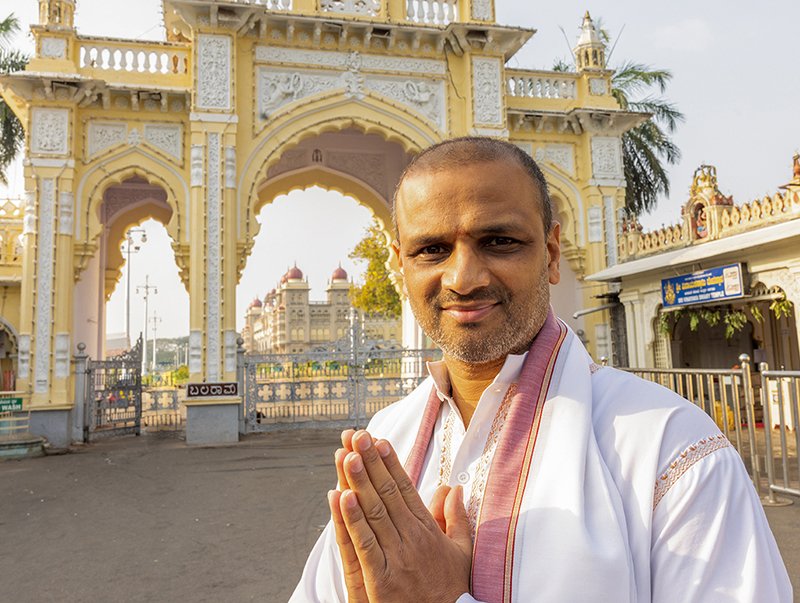THE BASICS OF YAMAS
Yamas are social observances—the way that you regulate behavior in relation to others. They are also powerfully transformative for the individual, bringing greater clarity and stability to the mind. Within this first limb of yoga, there are five yamas and each one can be considered a specific sādhana (a practice leading directly to a goal) that moves you closer to the state of yoga. The last yama, aparigraha (non-grasping), is the culmination of perfection of the yamas. Patañjali calls the yamas mahāvrata, which means great vows.
1. Ahimsa is synonymous with non-violence. It literally means not causing injury or pain to any other living being. You should aim to practice ahimsa not only by your actions, but also in your speech and thoughts as well. When you follow ahimsa at all times, you are not shadowed by the potential threats that come back to you as a result of your actions, whether physical, verbal, or mental. Patañjali says that one who practices ahimsa perfectly will influence all around him and they will also become non-violent.
2. Satya means truthfulness or honesty. You should practice it not just in words, but also in your thoughts and deeds. You should not speak the truth if it brings pain to others, but find ways to communicate truthfully without causing pain. A poignant quote from Mark Twain sums up this principle: “If you tell the truth, you don’t have to remember anything.” Hence, when you are always truthful, you do not experience the confusion and stress that results from lying or manipulating the truth, having to try to remember what you have previously fabricated. As you practice satya, you will become more aware of the way that you may manipulate the truth in order to obtain desired outcomes even at a very subtle level. Patañjali states that the actions of one who is perfect in satya will always be productive.
3. Asteya means not stealing and should be practiced in all areas of life. There is a beautiful story about a boy who found a man’s wallet and when he returned it to the distressed owner, he was offered a reward. The boy responded, “Why should I receive a reward for simply doing what is right?” This attitude of asteya inherent in the boy’s mind made it very clear in terms of what is and isn’t his. Patañjali says that when you practice asteya perfectly everything that you need will be available to you and you will be contented with the things that you do have.
4. Brahmacarya is the practice of sexual continence. For a monk or serious spiritual aspirant, absolute celibacy is inferred. In traditional society, brahmacarya is practiced by students during their spiritual training or studentship until their studies are finished and they get married. Once married, they should maintain an appropriate relationship with their partner. Sexual activity has the potential to divert you from the yogic or spiritual path when used inappropriately or excessively and depletes energy that can be channeled into spiritual progress. When that energy is harnessed and directed toward the goal of yoga, it is tremendously potent. Hence, Patañjali says that if you follow strict celibacy, you will gain great physical and spiritual vitality.
5. Aparigraha literally means non-grasping (non-possessiveness.) It infers that you should only take that which is necessary for maintaining yourself in a healthy way. Aparigraha extends to all areas of life and is an attitude toward not only food and physical possessions, but also to relationships with others and the world. By following aparigraha, you aim to cultivate an attitude in which you do not desire anything unnecessary. Practice of aparigraha brings an increased awareness of your underlying tendencies or desires. There is a greater awareness of your deeper motivations. Patañjali says that the result of being firmly established in aparigraha is an understanding of the reason for your janma, which may be interpreted as an understanding of your existence.
Related: The Eight Limbs of Yoga Explained
THE BASICS OF NIYAMAS
Niyamas are described as personal observances. They are internal disciplines: Attitudes or qualities that you should apply to both your practice and daily life in order to progress in yoga. Similar to yamas, there are five niyamas.
1. Śauca means cleanliness or purification. Bahir śauca, external purity, relates to cleanliness of your body and your immediate environment. Antaḥ śauca, internal or mental purity, relates to your thoughts and intentions. Patañjali says that by practicing internal purity, you will gain a happy disposition, greater concentration, control of your senses and become aware of your own soul.
2. Saṃtoṣa means contentment. You should practice being content with whatever your situation is and try never to feel regret. This does not mean that you need to accept bad situations, but rather that you should strive to improve them, maintaining contentment and recognizing that you can more effectively overcome difficulties if you have the clarity of mind that comes from a sense of contentment at all times. Patañjali says that by practicing contentment you will experience unsurpassed joy.
3. Tapas literally means work or heat. It is the effort that you take to discipline the body and the sense organs. Being disciplined in yoga practice and adhering to a healthy diet are two examples. Another would be the effort it takes to keep your attention and focus on the path of yoga at all times, applying the effort required to achieve the goal of yoga. Patañjali says that by tapas the body and the senses become purified, strengthening them for perfection in yoga.
4. Svādhyāya is self-study. Traditionally this referred to chanting and studying texts within your family lineage taught to you by a guru or teacher. These texts were deeply philosophical and contemplation on their meaning gave great spiritual insights, particularly the relationship between the Jīvātman, or individual soul, and the Paramātman, or god. In the context of yoga, it means that you should diligently study what you have learned from your teacher and go very seriously into the philosophy and practice of yoga, not simply accepting the words of the teacher on face value, but contemplating the meaning deeply for yourself.
5. Īśvarapraṇidhāna translates to depositing yourself in the supreme soul (Īśvara.) It can also be interpreted to mean depositing Īśvara within yourself. Patañjali does not define Īśvara as a particular form of God thus in yoga practice the word Īśvara can be interpreted in a way that is relevant for other spiritual traditions. It is only required that you place complete faith or devotion in the higher principle that you connect with. Patañjali states that if you have īśvarapraṇidhāna, you will attain perfect absorption in the eighth limb of samādhi.
My teachers have often said, and it has been borne out by experience, that without yamas and niyamas it is not possible to practice yoga at all. The practice of the other limbs of Aṣṭāṅga yoga only bear fruit when you follow them to the best of your ability and at all times.











Comments (0)